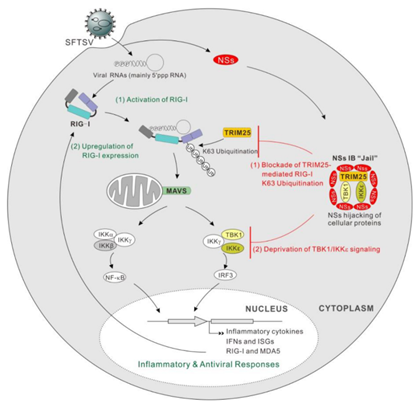Chinese Researchers Reveal an Arms Race between High-pathogenic Bunyavirus and Host Immunity
Date:20-07-2020 | 【Print】 【close】
Mammalian hosts have evolved a variety of cellular pattern recognition receptors (PRRs), which recognize viral nucleic acids or other conserved molecular components of invading microbes as danger signs and then trigger antiviral immune responses.
Severe fever with thrombocytopenia syndrome virus (SFTSV) is a notorious pathogen as the representative of high-pathogenic bunyaviruses, which can cause a severe hemorrhagic fever-like disease in humans, with high case fatality rates of up to 30%. To date, it is unknown how SFTSV is sensed by host cells and triggers immune and inflammatory cytokine responses.
Scientists from Wuhan Institute of Virology (WIV) of the Chinese Academy of Sciences, recently uncovered an interesting interplay of SFTSV infection with the signaling mediated by RIG-I, a critical cellular PRR localized in cytosol (Figure 1). They found that RIG-I plays a major role in the cellular recognition of SFTSV and the host immune/inflammatory responses to SFTSV infection, but in turn, is antagonized by the virus via hijacking of TRIM25 (an E3 ubiquitin ligase important for RIG-I activation) into viral inclusion bodies (IBs).
“The work not only gives the first detailed description of the PRRs sensing SFTSV infection and triggering immune and inflammatory responses but also suggests a novel viral IB-associated, RIG-I activation-targeting immune escape strategy, further enriching the role of viral IBs as the virus-built ‘jail’ previously proposed by us, and presenting an interesting example of virus-host arms race”, concluded by Drs. Fei Deng and Yun-Jia Ning, the corresponding authors of the study.
This study was published online on May 29, 2020 in the Journal of Biological Chemistry with the title of “A RIG-I–like receptor directs antiviral responses to a bunyavirus and is antagonized by virus-induced blockade of TRIM25-mediated ubiquitination”. Authors include Drs. Yuan-Qin Min, Yun-Jia Ning, Hualin Wang, and Fei Deng from State Key Laboratory of Virology, WIV, Chinese Academy of Sciences, Wuhan, China.
The work was supported by grants from National Natural Science Foundation of China (NSFC) and the National Key Research and Development Program of China.

Figure 1. Proposed model for the interplays between RIG-I signaling and SFTSV infection (Min et al., JBC, 2020)